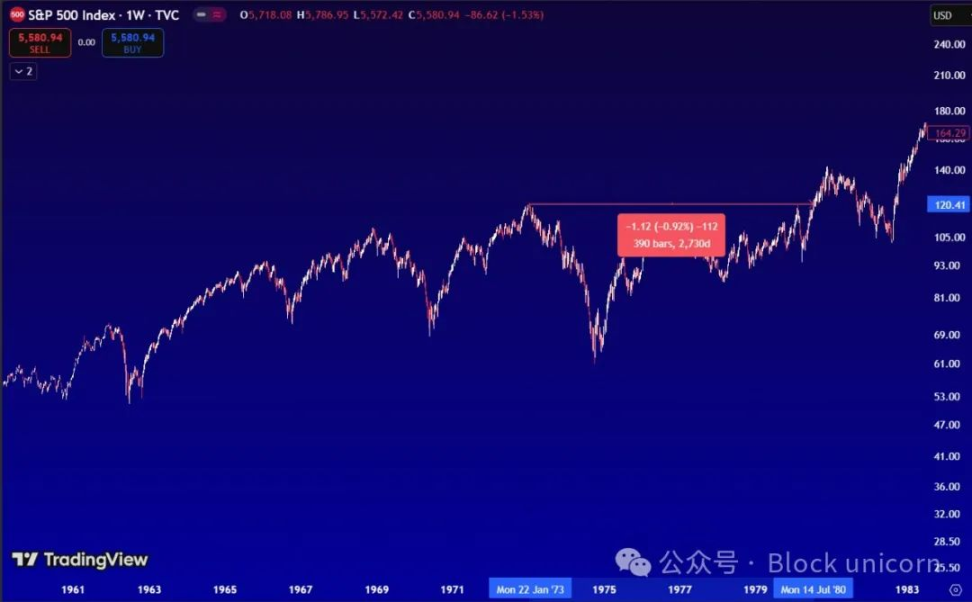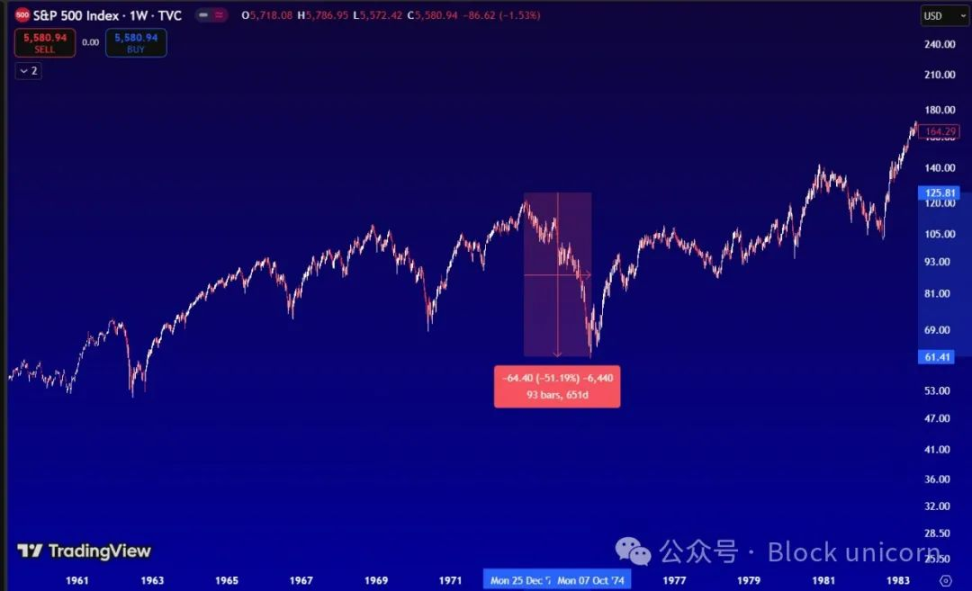What is the Bitcoin bear market like in the ETF era?

Reprinted from panewslab
04/02/2025·1MWritten by: VNTGPRN
Compiled by: Block unicorn
"Are we in a bear market now?" Overall, I think so. Each altcoin fell 40% or more (with a few exceptions). Bitcoin has fallen 23% as of this writing, and its previous local lows have fallen 30% and the current situation does not look optimistic. This time, every new altcoin or meme coin that made millionaires fell so badly that selling on each rebound was almost reasonable against the backdrop of weak Bitcoin and the broader macro and liquidity. But don't worry. As long as you don't over-long yourself in each 5% drop and destroy yourself, there will always be new opportunities. Also, I want to say I can't be sure where Bitcoin will go next. I'm a trader and I just know what price I want to buy and sell and then let the market do the rest. I want to speculate on what the Bitcoin bear market will look like when we are now in the traditional financial era of ETFs. This is the purpose of this article.
I reiterate that I don't know what will happen next. I know I want to buy at $70 low for a rebound, I know I want to sell at $88-90 resistance. All I can do is develop a contingency plan.

Scene 1: Indifference and fatigue
This bear market is likely to be worse than the last time. I'm not referring to the price aspect, I mean it can take years of oscillation to bottom out. I think the 75% callback in a year is far less painful than the 50% callback in a three-year period. Imagine you were an investor trying to buy the S&P during the stagflation period in the 70s. Although there are many opportunities, it took 7 years to hit a new high (1973-1980). In addition, the second downtrend in the 1970s took 2 years to complete a 50% pullback. The first correction also took nearly 2 years to complete a 38% decline (November 1968 to June 1970). Also remember that this is a period of stagflation, namely high inflation, low growth or negative growth. By actual value, that 50% callback is much worse than it seems. I'll talk more about stagflation later because I think it's the worst case for a broader economy.

Extremely cruel price trends over seven years.

Continuous decline in the past two years.
I would say that this decline is largely predictable and may not be obvious for crypto-natives who spend 90% of the time trading unpopular instruments with low liquidity requirements, but for those who are concerned about U.S. trade policy (tariff), U.S. domestic policy (DOGE, massive deportation), and valuation of large tech companies, they have been quietly exiting the risk since November last year. I think this is the initial correction because these large pools of funds are exiting the market. This has turned the market to a defensive trend, causing people to hedge their positions even if there is a slight downside risk. With the adoption of traditional finance for various Bitcoin financial products (CME futures, Ibit options, etc.), there are many liquidities that can be used to buy and sell various hedging tools.
In my opinion, I can see a scenario unfolding that is absolutely devastating for cryptic natives chasing the green K-line. Everyone knows how bad the Bitcoin bear market is. So far, the 75% drop has been normalized, which is one of the reasons why people are even reluctant to participate. Although it performs well by risk-adjusted returns, it is too volatile for many. However, there are now liquid markets that can hedge against this volatility and downside risks. Enter IBIT options. The painful slow down scenario may be due to the options market, and from a mechanism perspective, it will unfold like this. Larger participants buy put options to hedge their spot exposure. Put options become very expensive, so market makers are happy to sell these options. Market makers need to hedge their short put positions by selling appearances and keeping delta neutral, or adjusting for other positions. Many of these market makers close short positions, buy spot or adjust positions to restore delta neutrality near the option expiration date. Assuming it is in a low liquidity environment (bear market), this may cause one of two situations to occur.
1. Spot buying pressure and short closings from market makers slowed any downward movement near the option expiration date, causing the price to fall to its target in a very slow manner within months, accompanied by a large amount of oscillation and volatility near the option expiration date.
or
2. Buying pressure and short closings from market makers are enough to drive prices up near the option expiration date, and when these put options expire, market makers close their short positions to restore delta neutrality. Volatility near the option expiration date has increased, and everyone except those who sell put options at high premiums have lost money. This cycle continues until the seller overwhelms any passive buying, or more marginal sellers enter the market by giving up their positions.
Of course, this assumes a lot of things. As I said, this is not my basic scenario, but it is certainly something to be aware of. Additionally, if the premium of put options is extremely high, it may indicate that people are afraid of market declines, and if sellers overwhelm market makers’ buying, spot prices may still fall. Hedging pressure from market makers is just one factor – it does not operate in a vacuum environment. Furthermore, if implicit volatility rises significantly (pushing those expensive premiums), market makers may hedge other tools such as futures or offset call options, diluting the direct impact on spot prices.
Again, this is the worst case in my opinion, because every tiny rebound is a silver lining for many who still think it is a bull market.
Regarding stagflation, this is the most terrible nightmare for central bankers. This is a failure of the dual mission of stabilizing prices and balancing the labor market. High inflation and low growth have once again become the worst case for the overall economy, which is absolutely disastrous for the financial market. The only possible thing I can see that during stagflation is gold, even so, will you be confident to chase highs? At present, there are early signs that stagflation is brewing. Core personal consumption expenditure has been raised. GDP estimates are weakening (to be fair, that has a lot to do with government layoffs), and many market commentators are yelling stagflation as a new hot topic bait. I don't think this is likely to happen yet. I want to see more data to confirm this, as I'm reluctant to build a multi-year argument based on a few soft/hot metrics. I would also like to add that if you were a central banker, would you be willing to lose in both aspects of your dual mission? Or will one sacrifice one to save the other? Time and time again these central bankers have proved that they would rather accept high inflation than face a catastrophic deflation spiral that threatens the foundations of the financial system. So, will they take risks? Maybe they are reacting too slowly to the economic deterioration. This is something I don't know, but I don't want to experience it either. So I think it's a possibility and once I have enough confirmation, I'll take action.
Scenario 2: This time it's no different
This may be the better of the two bear market scenarios. Each encryption cycle ends in the same way. Bitcoin peaked, and amid the craze for Bitcoin to peak, people increased their leverage exposure. Smart funds exited and people began to be liquidated, resulting in a sharp pullback from all-time highs. Bitcoin fell slowly, occasionally rebounding, but was rejected when retested and eventually lowered further. An exchange or large-scale fund or both collapsed simultaneously, resulting in an ultimate surrender, down 70-80% from an all-time high, with everyone claiming that the asset class is dead, and during a brief consolidation at the bottom, those selling near the top began to set the bottom.
I say this is the best scenario because it offers a lot of opportunities. You can get one more entry opportunity for a generation. You have a chance to succeed quickly again. In this case, I think it will last up to 14 months.
But I think this is less likely. My reason is that the market has matured a lot and liquidity has also improved greatly. Many large holders have a large supply and have not used much leverage at all. Extreme pricing efficiency like 80% pullbacks are not a big deal in more mature markets, as people have liquid options to hedge their exposure. Again, some catastrophic, cryptocurrency-specific situations must happen before we can reach that point. This is possible, but it is only open for five or five. Still, altcoins are easily called back 50-60% here again. In this environment, who is the marginal buyer of altcoins? Traditional finance is turning to hedging, crypto-indigenous people are exhausted, crypto-market liquidity is scattered, and everyone is waiting to see if Bitcoin will pull back 20%. The only argument that supports "this time difference" is that altcoins have not ushered in a real altcoin season, but why is this happening? There are hundreds of new altcoins, none of which offer new practicality. Furthermore, they do not need to hold value to provide this practicality, and in many cases, they are better functional when they are cheaper. I think in this case, capital will continue to rotate in PVP type markets among various altcoins, and no sector is significantly better than other sectors, and the entire altcoin system will fall 90% from its historical high. The only argument I can see about the recent rise in altcoins is the major positive catalysts in traditional finance adoption (RWA, stablecoins, etc.), but this kind of thing takes months or even years to fully establish.
I want to end this chapter with a positive tone. However, I also want to reiterate that this situation becomes increasingly unlikely as each rebound fails. In the medium term, I am neutral to slightly bearish, and with that being said, I make mistakes often, but I make sure to keep most of the money when I make mistakes so that I get an excess return when I am right.
Scenario 3: This is a callback similar to the summer of 2021
I think it's very unlikely, but again, I'm just a trader. I don't know anything except what I want to buy and sell, at what price, and how much I buy and sell. Given the environment we are in, the best situation you can expect is that Bitcoin has little movement in the coming months, just sideways trading. I don't even think the most optimistic headlines now can drive Bitcoin to continue to rise. Every rebound will be sold out. Before the liquidity environment becomes more easing for risky assets, before trade policies are more certain, and before economic data show moderate growth and slowing inflation, your main goal should be to secure capital.
I will make another statement that my view in the medium term is that neutral is slightly bearish. My basic assumption is that we won’t hit all-time highs until economic and geopolitical uncertainties are largely resolved. However, you are not making money from predictions to earn and retaining financial markets. You earn and retain funds by preparing for each scenario and adjusting your position based on these events. From a trading perspective, if you plan to go long, remember to lock in profits every time you rebound. Now is a great market for traders and you can still make profits from this market as long as you have patience and discipline. Don’t chase the rise, and don’t be greedy. If you want to short, be careful. Bitcoin has fallen by nearly 30%, and altcoins have fallen by more than 50%.
I will be the first to tell you that staying optimistic will make you earn more. There is greater room for growth in the financial market. However, now is one of the moments when you should be ready for further downside. There are more things that can go wrong here, and while many things have been going well, the price still hasn't responded favorably for any longer.

